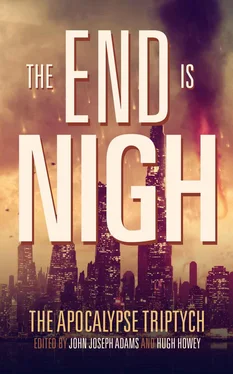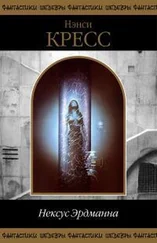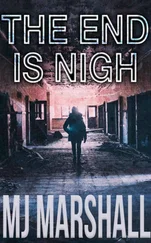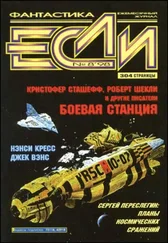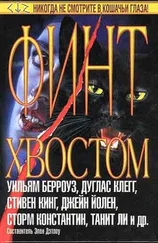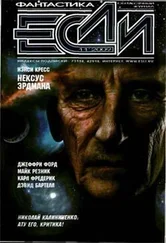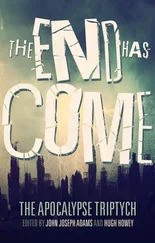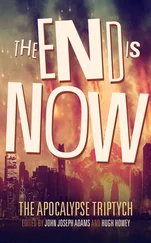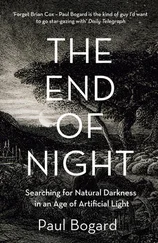John Joseph Adams — INTRODUCTION
“It was a pleasure to burn. It was a special pleasure to see things eaten, to see things blackened and changed. With the brass nozzle in his fists, with this great python spitting its venomous kerosene upon the world, the blood pounded in his head, and his hands were the hands of some amazing conductor playing all the symphonies of blazing and burning to bring down the tatters and charcoal ruins of history.”
Fahrenheit 451 Ray Bradbury
I met Hugh Howey at the World Science Fiction Convention in 2012. He was a fan of my post-apocalyptic anthology Wastelands , and I was a fan of his post-apocalyptic novel Wool . Around that time, I was toying with the notion of editing collaborative anthologies to help my books reach new audiences. So given our shared love of all things apocalyptic—and how well we hit it off in person—I suggested that Hugh and I co-edit an anthology of post-apocalyptic fiction. Obviously, since his name is on the cover beside mine, Hugh said yes.
As I began researching titles for the book, I came across the phrase “The End is Nigh”—that ubiquitous, ominous proclamation shouted by sandwich-board-wearing doomsday prophets. At first, I discarded it; after all, you can’t very well call an anthology of post-apocalyptic fiction The End is Nigh —in post-apocalyptic fiction the end isn’t nigh , it’s already happened !
But what about an anthology that explored life before the apocalypse? Plenty of anthologies deal with the apocalypse in some form or another, but I couldn’t think of a single one that focused on the events leading up to the world’s destruction. And what could be more full of drama and excitement than stories where the characters can actually see the end of the world coming?
At this point I felt like I was really onto something. But while I love apocalyptic fiction in general, my real love has always been post-apocalypse fiction in particular, so I was loathe to give up on my idea of doing an anthology specifically focused on that.
That’s when it hit me.
What if, instead of just editing a single anthology, we published a series of anthologies, each exploring a different facet of the apocalypse?
And so The Apocalypse Triptych was born. Volume one, The End is Nigh , contains stories that take place just before the apocalypse. Volume two, The End is Now , will focus on stories that take place during the apocalypse. And volume three, The End Has Come , will feature stories that explore life after the apocalypse.
But we were not content to merely assemble a triptych of anthologies; we also wanted story triptychs as well. So when we recruited authors for this project, we encouraged them to consider writing not just one story for us, but one story for each volume , and connecting them so that the reader gets a series of mini-triptychs within The Apocalypse Triptych. Not everyone could commit to writing stories for all three volumes, but the vast majority of our authors did, so most of the stories that appear in this volume will also have sequels or companion stories in volumes two and three. Each story will stand on its own merits, but if you read all three volumes, the idea is that your reading experience will be greater than the sum of its parts.
In traditional publishing, this kind of wild idea—publishing not just a single anthology, but a trio of anthologies with interconnected stories—would be all but impossible, so it was just as well that Hugh and I had already decided to self-publish. But the notion that this was something that traditional publishing wouldn’t—or couldn’t—do made the experiment even more compelling, and made working on this project even more exciting.
Post-apocalyptic fiction is about worlds that have already burned. Apocalyptic fiction is about worlds that are burning.
The End is Nigh is about the match.
Robin Wasserman — THE BALM AND THE WOUND
Here’s how it works in my business: First, you pick a date—your show-offs will go for something flashy, October 31 or New Year’s Eve, but you ask me, pin the tail on the calendar works just as well and a random Tuesday in August carries that extra whiff of authenticity. Then you drum up some visions of hellfire, a smorgasbord of catastrophe—earthquake, skull-faced horsemen sowing flame and famine in their wake, enough death and destruction to make your average believer cream his pants—and that’s when you toss out the life-preserver, the get-out-of-apocalypse-free card. Do not pass go , do not collect $200, do not get consumed by the lake of righteous fire, go directly to heaven on a wing and a prayer and a small contribution to the cause, specifically the totality of your belongings and life savings, 401Ks and IRAs—for obvious reasons—included.
Here’s how it’s supposed to work in my business: You tuck that money away for safe keeping, preferably in a bank headquartered in a non-extradition country, await the end days with clasped hands and kumbayas, and then, when the sun rises on an impossible morning, oh, you praise the Lord for hearing your prayers and offering a last minute reprieve, you go ahead and praise yourself for out-arguing Abraham and saving your modern day Sodom and Gomorrah, and let’s all give thanks for living to pray another day, even if we live in bankruptcy court.
If you don’t have the juice to pull that one off, there’s always the mulligan— oopsy daisy, misread the signs, ignored the morning star, overlooked the rotational angle of Saturn, forgot to carry the one, my bad . Dicey, but better than drinking the Kool-Aid—and if you can’t envision a Great Beyond worse than prison, you might be in the wrong line of work. You do your job right, by the time the fog clears and the pitchforks and torches hit your doorstep, you’re long gone, burning your way through those lifetimes of pinched pennies one piña colada at a time.
Like I said: Supposed to.
I’m a man who likes a back-up plan, a worst-case-scenario fix for every contingency, a bug-out route in case anything goes wrong. Never occurred to me to plan for being right.
The signs are bullshit. Have to be. You know who “read” the signs? Pick your poison: Nostradamus. Jesus Christ. Jim Jones, Martin Luther, the whole Mayan civilization. Every flim-flam man from Cotton Mather to Uncle Sam. And every single one of them screwed the pooch. Then, somehow, along comes me. You know what they say about those million monkeys banging away on their million typewriters until one of them slams out Hamlet ?
Just call me Will.
• • • •
Hilary dumped the kid five days after I made the prophecy, nine months before the end of the world. I remember, because by that point the Children had rigged up the calendar, a blinking LCD screen hanging over the altar to keep them constantly apprised of the time they had left. Nine months had seemed an auspicious period—long enough for the kind of slow burn panic that empties wallets but stops short of bullets to the brain, brief enough that I could keep smiling and stroking the Children of Abraham without letting slip that I wanted to throttle every insipidly trusting last one of them. But Hilary tracking me down had me questioning the timeframe, and not just because she dumped her stringy ten-year-old in my lap and took off for greener and presumably coke-ier, pastures.
I’d only been Abraham Walsh, né none of your concern, for the last five years, and before that Abraham Cleaver, and before that , back in the days when Hilary had decided to fuck with her parents by fucking the itinerant faith healer, Abraham Brady. If a headcase like her had managed to track me through three names, ten years, and twelve states, who knew how many cops, parishioners, shotgun-toting fathers or snot-dripping toddlers might have picked up the trail?
Читать дальше
